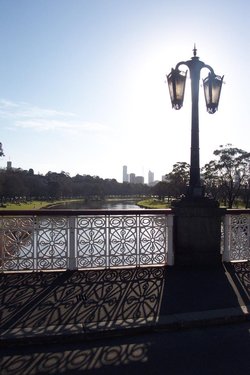Yarra River
|
|
Melbourne_Yarra.jpg
The Yarra River is a river in southern Victoria (Australia), originally called Birrarung by the Wurundjeri people who occupied the Yarra valley prior to European settlement. Its lower reaches travel through central Melbourne. It is approximately 242 kilometres in length, and its mean annual flow is 718,000 megalitres. Like virtually all of Australia's rivers, annual flows vary greatly due to the effect of El Niņo.
The river's source is a series of swamps on Mount Baw Baw. The upper reaches are located within the Yarra Ranges National Park, a thickly forested subalpine park, and are entirely closed-off to all except the employees of Melbourne Water. The park features extensive stands of mountain ash, a very tall eucalypt, tree ferns, as well as patches of remnant rainforest.
The Upper Yarra Dam, one of a number of dams in the Yarra Catchment that supply most of Melbourne's water, is the furthest upstream point on the river visible to the general public (though the dam itself is closed off).
The first settlement the still-young river passes through is the small town of Reefton, but most of the river is surrounded by hills covered temperate forest until the subalpine resort town of Warburton. The Woods Point Road follows the river through this section.
Downstream of Warburton, the Yarra Valley gradually opens out and farms begin to appear, including beef and dairy farms, and by the town of Woori Yallock and the river's turn north increasingly large areas are covered by vineyards, forming the Yarra Valley wine region.
At Healesville, the river turns west again and the stream bed becomes increasingly silty, reducing the clarity of the water, and by the commuter town of Yarra Glen it begins to take on the brownish color that the lower reaches are known for.
The river enters Melbourne's suburbs proper at Chirnside Park, but virtually all the river's length is surrounded by parkland, much retaining (or having been replanted with) extensive native vegetation. A bicycle and walking trail begins at Warrandyte and becomes the Yarra River Trail, and in the lower reaches, the Capital City Trail. The river is used extensively for kayaking at Templestowe, and canoes can often be seen throughout the suburban section. Whilst the water is not particularly clear, its quality is sufficient for edible fish to swim within it. Some small hobby farms are located in the floodplain area of the river, surprisingly close to central Melbourne and almost completely surrounded by suburbs.
Heidelberg formed the home of the Heidelberg School, widely considered the first European painters to accurately capture the Australian landscape and its distinctive features. The walking trail features placards displaying some of their paintings at the settings they were actually painted. Some features remain clearly recognisable.
Below Dights Falls at Yarra Bend Park in inner Melbourne, the river becomes increasingly estuarine as it passes along the southern side of the central business district. This area forms the venue for the annual "Moomba" festival, which notably features an annual water skiing competition which attracts a huge crowd. Many of Melbourne's private schools, located close to the river, train their rowing crews on it.
Yarra_Panorama.jpg
Most of the inner metropolitan section of the river remains contaminated from industrial and domestic waste dumping dating from Melbourne's early settlement. The worst of this was eliminated through the 20th century, and since the 1980's a concerted effort to clean up the river has reduced pollution markedly, though not enough to permit swimming below Dight's Falls at present.
The lower reaches feature a number of boat cruises, using especially low-roof boats to go under the many bridges across this section of the Yarra. The final section passes through the Port of Melbourne and under the Bolte Bridge and the West Gate Bridge.
The river flows into Port Phillip Bay, the site being extensively altered as part of the Port of Melbourne, Australia's busiest seaport.
The total catchment area is approximately 4000 square kilometres.
Some of the Yarra's major tributaries include the Maribyrnong River, Plenty River, the Merri Creek, Darebin Creek and the Moonee Ponds Creek.

